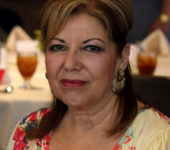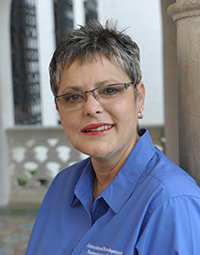• by Nilka Avilés, Ed.D., and Juanita C. García, Ph.D. • IDRA Newsletter • September 2014 •

Picture fifth graders gathered around a table where teachers are modeling the effects of sand erosion by wind and water. They then plan a set of learning centers that they themselves will lead for fourth graders. This scene is Science Camp at Gus Guerra Elementary where fifth graders participated in an engaging series of learning centers to master science concepts.
IDRA’s South Central Collaborative for Equity has partnered with the school to engage in changing the campus culture to one that is child-centered, college going and highly engaged with parents and community. Every child, regardless of characteristics and identified needs, is challenged to reach high standards and is given requisite pedagogical, social, emotional and psychological supports.
The major goals are to increase the school’s effectiveness in science, technology, engineering and math (STEM) and to increase academic language by particularly integrating the linguistic demands of the STEM areas into the curriculum. Through intensive language development and strengthened core content instructional programs designed to increase comprehensible input and acquisition of academic language among all student groups and across grade levels, the campus is succeeding in preparing primary grade students for upper elementary grades, middle school, high school and college.
This is being accomplished through a well-aligned multidisciplinary approach and strengthened instruction that incorporates dynamic and highly interactive instruction for all fourth and fifth grade students. IDRA’s approach to professional learning values the role of teachers, administrators, parents and students as co-creators of a campus culture where student voices are heard and incorporated into the curriculum and other campus activities designed to strengthen both students’ academic pursuits and non-cognitive factors that are crucial to their engagement and academic success.
Why STEM in Elementary School?
Children inherently have inquisitive minds and are natural scientists and problem-solvers. They make sense of the world around them by using all their senses to discover, take apart, build and create. This kind of learning is fun and exciting. This excitement must continue as children enter school and progress throughout their educational journey to ensure skilled workers in STEM-related fields who are equipped to lead and sustain our economy. The best way to ensure returns on these investments is to start fostering these skills in young children. Evidence has been growing over the last decade showing the significant effect of math and science experiences as early as prekindergarten on later learning and attitudes toward STEM (NSB, 2010; NAEYC & NCTM, 2010).
Effective teachers play a vital role in nurturing the natural enthusiasm for scientific learning children bring. How can elementary teachers make STEM part of what their students do in the classroom every day? Our collaborative partnership involved four critical elements that teachers have embraced and adapted to lead their students to a successful STEM education.
1. Shifting the Paradigm from Teacher-Centered to Student-Centered Instruction
Student-centered instruction has its roots in constructivist theory of learning. In constructivist classrooms, students build their understanding of the world as a result of their actions. IDRA staff educators and Gus Guerra Elementary School teachers and administrators reviewed areas of need in math and science and agreed on the topics to be modeled in their classrooms. Armed with research-based and highly-interactive strategies for engaging all students, including English language learners, IDRA modeled lessons and debriefed with teachers on what they observed. The teachers committed to create an environment where STEM was a natural and real part of the curriculum. When a classroom operates with student-centered instruction, students and teachers share the focus interacting equally.
2. Empowering and Valuing Teacher Strengths
Teachers have a profound impact on students’ lives. IDRA recognizes the tremendous capacities all teachers have acquired through their years of experience. The best teachers believe in their students, challenge and inspire them, and urge them to take risks in learning.
The climate established at Gus Guerra Elementary School is that of respect, valuing backgrounds and strengths, and incorporating these daily in profound ways into the classroom. IDRA educators built on teachers’ leadership capacities and capitalized on campus leadership, mobilizing the principal, teachers, support staff and parents as a force to share the responsibility for STEM education. Together they created a vision to reach high standards of excellence in conjunction with a meaningful professional development for teachers.
3. Building Trust and Fostering Confidence
Through coaching and mentoring experiences, teachers emerged to become more confident and comfortable in teaching STEM concepts. After observing IDRA staff, teachers took leadership roles by developing lessons that include strategies they had learned to foster innovation and cultivate problem solving and logical thinking. By integrating STEM activities in lessons, teachers experienced successful outcomes, such as increased student engagement in learning, improved benchmarks and STAAR results, self-accountability, gaining trust, and becoming confident and competent. These opportunities convinced them to nurture their creativity and become innovative risk takers to be successful. Teachers realized their enormous strengths and how they were able to build on them.
4. Establishing a Sustainable Cultural Transformation
The school administration and teachers are committed to transforming the role of STEM in the curriculum and the way they teach STEM areas, ensuring that all students succeed while creating a sustainable, robust and open pipeline for STEM. To sustain the effort, school staff gathered and shared ideas and resources and developed lessons to support this transformation. The vision and new culture at the campus has led to the promotion of engaged and motivated students who value STEM and are better equipped to face the role they play in our society to address scientific, social and the economic challenges of our world. The school has experienced a sustainable cultural transformation where teachers and students learn the same way scientists and mathematicians learn – by doing. Educating the next generation of scientists, technologists, engineers and mathematicians with the skills from high quality hands-on teaching experiences fosters critical thinkers who adapt to change, an essential component to any future career.
Successful teaching and learning begins with a vision of providing quality and culturally relevant opportunities for all students. The principal of the school, Rebecca Sánchez, deserves much credit for motivating teachers to become leaders and risk takers.
Educators Reflect on their Experience with IDRA’s Role in School Transformation:
“It has been rewarding to observe the students taking ownership of their roles as they worked cooperatively in guiding each other to accomplish their tasks.”
– Teacher, Gus Guerra Elementary School
“The experience with IDRA was second to none. We are looking forward to working with IDRA in the years to come.”
– Teacher, Gus Guerra Elementary School
“The experiences that have been provided by IDRA have been priceless when it comes to student engagement and the level of critical thinking students have exemplified.”
– Campus instructional coach, Gus Guerra Elementary School
“For several years now, IDRA staff have mentored and coached teachers in fourth and fifth grades and has been instrumental in empowering teachers with strategies and tools to positively impact student learning. We have begun to reap the rewards and have begun to transform each classroom into a powerful teaching and learning community. We have made significant gains in the area of science. Last year, we were one of only seven campuses in PSJA ISD that met Adequate Yearly Progress (AYP). Although we have much to celebrate, we must remember, Todavía no podemos cantar victoria. We still have much to accomplish. We believe that with IDRA’s collaboration, we can continue to transform our students, our school and our community.”
– Rebecca Sánchez, principal, Gus Guerra Elementary School
Resources
Avilés, N. “Building College Readiness for All Students,” IDRA Newsletter (October 2013).
Avilés, N. “The Need for Minority High Schools with a STEM Focus,” IDRA Newsletter (February 2012).
García, J. & Rodriguez, R. “Building Interest in STEM,” IDRA Newsletter (January 2014).
Johnson, P. “A Valuing Professional Development Model,” – Podcast Episode 143 (July 28, 2014).
NAEYC & NCTM. Early Childhood Mathematics: Promoting Good Beginnings, A joint position statement (Adopted in 2002; Updated in 2010).
National Science Board. Preparing the Next Generation of STEM Innovators: Identifying and Developing Our Nation’s Human Capital (National Science Foundation, 2010).
Nilka Avilés, Ed.D., is a senior education associate in IDRA Field Services. Juanita C. García, Ph.D., is an education associate in IDRA Field Services. Comments and questions may be directed to them via email at feedback@idra.org.
[©2014, IDRA. This article originally appeared in the September 2014 IDRA Newsletter by the Intercultural Development Research Association. Permission to reproduce this article is granted provided the article is reprinted in its entirety and proper credit is given to IDRA and the author.]



